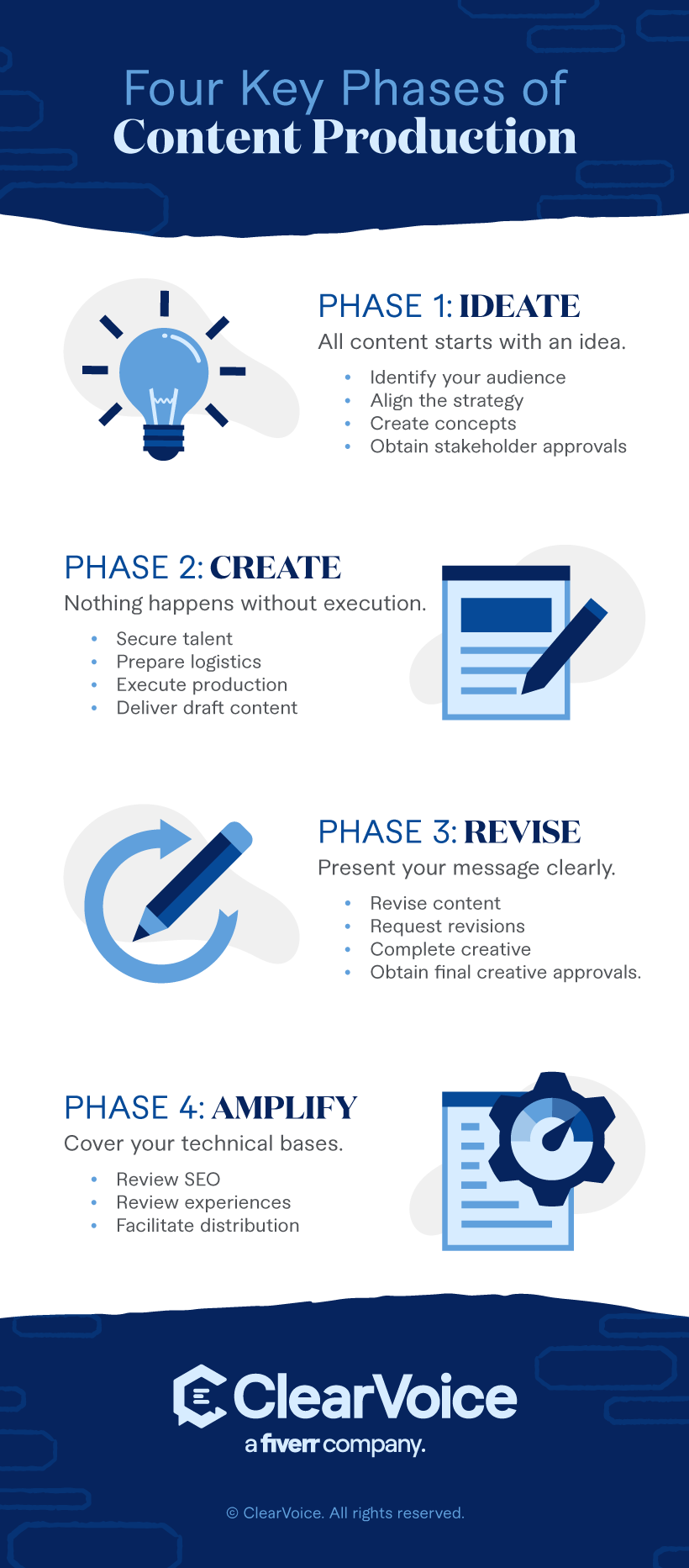Content creation is the intentional, strategic process of crafting text and visuals that align with the core interests of your audience and brand to reach documented business goals. Generating content requires mindful planning and diligence. Once the creation process is mastered, the resulting custom content can boost engagement, attract leads and close sales, in turn growing your business and industry influence.
Prefer to read a PDF? Download our eBook version of this post.
Time. There’s never enough when it comes to content production and distribution. You know creating content is the backbone of your inbound marketing approach, and brand reputation hinges on quality. But how can you get the writing done consistently? Where do you find additional talent to assist with campaign ideation and content creation? And how in the world do you scale all this to meet the growing and evolving needs of your customer base?
You embrace a process.
Think of this. You wouldn’t suddenly decide to climb a mountain and hope for the best experience while gazing at the summit from the parking lot. Instead, you plan for a successful journey. You map out a training program to optimize your health, research the proper tools for the environment and go on multiple practice hikes to prepare for the main event.
“A brilliant strategy, blockbuster product, or breakthrough technology can put you on the competitive map, but only solid execution can keep you there. You have to be able to deliver on your intent. Unfortunately, the majority of companies aren’t very good at it, by their own admission.” — Harvard Business Review
As you dream of how to navigate your next content marketing campaign, go all-in with a success mindset — and documented process.
What is content creation?
Content creation is the intentional, strategic process of crafting text and visuals that align with the core interests of your audience and brand to reach documented business goals. Generating content requires mindful planning and diligence. Once the creation process is mastered, the resulting custom content can boost engagement, attract leads and close sales, in turn growing your business and industry influence.
You’re not alone in your struggle to tackle content creation on an ongoing basis. Seeking content marketing help and the task of content creation were cited as the top challenges among 2,830 marketers surveyed by ClearVoice in 2019. Surprisingly, the respondents explained that content creation was seven times more of a pain point than content strategy. It’s time to look closer at why the output step is so challenging.
Why do you need a content creation process?
Without the proper preparation and gear, mountain climbers stumble, make errors, and… go missing. Is that what you want for your business? We know it’s not.
Adopting a content creation process can:
- Make content production and publication consistent.
- Give your marketing team clear instructions and task lists.
- Maintain regular engagement with your audience.
- Bolster your overall marketing strategy and approach.
In HubSpot’s State of Inbound report, HubSpot Research found that 53 percent of marketers believe inbound marketing gives their organizations higher ROI than outbound marketing.
Bottom line: It’s best not to half-ass your content creation.
If your current workflow (or even your agency’s workflow) relies on trickles of inspiration, squeezing asset creation into unexpected open blocks on the calendar, pushing links out for the world to see, and hoping they go viral as you sit back and watch the analytics populate, you can do better.
A HubSpot study of blogging data accumulated from 13,500+ of their customers found, “companies that published 16+ blog posts per month got about 4.5X more leads than companies that published between 0 – 4 monthly posts.”
Quadruple the leads! Can you imagine going into a meeting with the marketing and sales teams and reporting those numbers? We can. Shift your workflow to intentional ideation, creation, revision, and optimization.
4 Key Phases of the Content Creation Process:
Here’s the outline of the four phases in the ClearVoice content creation process.
- Ideate: All content starts with an idea
- Identify audience
- Align strategy
- Create concepts
- Obtain concept approvals
- Create: Nothing happens without execution
- Secure talent.
- Prepare logistics
- Execute production
- Deliver draft content
- Revise: Present your message clearly
- Revise content
- Request revisions
- Complete creative
- Obtain final creative approvals
- Optimize: Cover your technical bases
- Review SEO
- Review experiences
- Facilitate distribution
Phase One of Content Creation: Ideate
All content starts with an idea.
Ideas, the pure, robust fuel for content creation, emerge as random thoughts and slowly take shape as we work a bit of logical processing magic. Whether you’re jotting keywords down on a whiteboard in a boardroom, or taking mental notes in the shower, hold fast to those seeds of content. Nurture them to discover their viability.
“There is one thing stronger than all the armies in the world, and that is an idea whose time has come.” — Victor Hugo
Do your ideas speak to your audience? Do they align with your branding strategy? Do they tell a story? Do they fit within your resources? Let’s find out.
1. Identify your audience
Brilliance shared with the wrong people goes… nowhere. Do you know who your target audience is, what they care about, and where they’re hanging out today? If your audience analysis and buyer persona vignettes are already a year old, they could be outdated.
Discover real-time audience trends and define your customer’s journey by focusing on current consumer behaviors, advises SEMrush. People make buying decisions based on multiple, fluid factors, creating an overlap in how they associate and engage with your brand day-to-day.
For example, an ambitious mountain climber is obviously searching for gear at outdoor adventure stores. But maybe she’s also browsing protein shake options at health food retailers and the latest HIIT workouts on YouTube. Discovering this overlap in current audience interests (SEMrush has a tool for that) lets you better understand and identify who you’re speaking to, to determine if your ideas are in alignment with your audience’s core needs and interests at this time.
With additional analytical digging, you can also discover what types of content resonate with your specific audience and will help move them through the customer journey. Let’s say your strategy calls for blog posts and podcast episodes. Then, you discover your most active engagements online are happening on video clips posted to Facebook.
After all, more than 80 percent of people check social media at least once per day. When it comes to Facebook, it’s the go-to for 87 percent of millennials, 90 percent of Gen X and 96 percent of baby boomers, according to a study by The Manifest regarding social platform usage.
If this scenario sounds familiar, it’s time to pivot!
Questions you should ask when you’re identifying your audience:
- Have you determined your target audience?
- Have you assessed your audience’s needs and desires?
- Have you determined particular personas to address?
- Have you identified the types of content to best engage your audience?
- Have you determined if you will collaborate with your audience?
2. Align strategy
Why you do what you do — whether it’s offering services, products, or both — is ultimately guided by your brand’s goals. Have you defined them? Have you documented them? Have you integrated them into your content strategy?
Goal setting increases the level of production by an average of 19 percent, according to a theory developed by psychologist Edwin A. Locke, Ph.D., the Dean’s Professor (Emeritus) of Leadership and Motivation at the R.H. Smith School of Business at the University of Maryland, College Park.
If you’re in need of a refresh (or fresh start), here are a few highlights of Lockes highly regarded findings:
- Goals should be specific. Instead of stating, “we need to create more blog posts this year,” create a statement such as, “We will increase from one blog post per month to one blog post per week by implementing the assistance of two freelance writers, which are accounted for in our marketing budget and managed by our in-house content director, starting on the first of next month.”
- Goals should be achievable. Do your aspirations fit within your time, monetary, and staffing resources? In the above example, the blogging goal is only achievable if you indeed have the budget and management available.
- Goals should address groups and individuals. Think of the marketing team as a whole, and express goals that want to be achieved for the greater good of the company. Then, identify how each individual within the team will funnel their talents into this process.
As you solidify your goals, build upon your content strategy by researching the types (and performance of) content you want to create. Is your audience indeed responding to the content concepts you’re proposing, or are they simply something you think would perform well? Can you find a balance between both?
Have you outlined the KPIs for the goals you’ve set? Can you estimate how the content you plan to create will funnel into the benchmarks? Use these hypotheses to later measure the success (or failure) of your strategy.
Did you look to others in your industry? Completing a competitive analysis of their current marketing efforts and gleaning what’s working can give you a leg up on what to try or steer clear of.
Communicate with stakeholders. They have a vested interest in seeing you succeed, and although they don’t likely have the marketing prowess you possess, they do know investments. Listen for nuggets of direction.
As you finesse your strategy and know without a doubt that it aligns with your goals and corporate intentions, update your documented branding and style guidelines to share with all team members, both in-person and remotely.
Questions to ask when aligning your content strategy:
- Have you identified your brand’s goals?
- Have you gathered any research to consider in the content concept?
- Have you estimated the impact of content on the KPIs for those goals?
- Have you done a competitive analysis of your competitors and their content?
- Have you collaborated with or sought input from key stakeholders?
- Have you created brand and style guidelines for your content?
Here are a few resources to help you get started:
- 7 Meaningful Activities to Develop Your Brand’s Voice
- How to Make an Editorial Style Guide That’s Freelancer-Friendly (With Templates for Google Slides, PowerPoint, and PDFs)
3. Create concepts
As you move forward in your ideation process, from identifying your audience to aligning your strategy, you’ll fine-tune the concepts you want to bring to life. But what does this look like?
In content marketing, storytelling has become a dominant approach to attracting, engaging, and winning over potential consumers. Screenwriting lecturer and teacher Robert McKee stresses the need for business leaders to think like authors in his book, ‘Storynomics Story-Driven Marketing in the Post-Advertising World.’
On page 29, he explains, “We advocate a solution that’s tens of thousands of years old, the mode of communication that best fits the mind, that best connects one mind with another, that wraps the clarity of a rational message inside an emotional package and delivers it with sticking power: story.” He goes on to elaborate that in the always-on, digital world, the ability to capture attention is a marketer’s single most valuable asset.
So, what kind of story do you want to tell? How will it play out? Via an interactive quiz or multi-page PDF download? Does the concept align with your goals and strategy? Does it differ from what your competition is producing? Once you’ve nailed down a creative concept, decide who will help you make it a reality. Is your internal team up to the challenge? Will you need to bring on freelance content creators to bring more skills and energy to your team?
Finally, wrap up your concept with a bow in a compelling creative brief. This essential document outlines all the project details (and links to additional resources) needed to execute the content creation.
Questions to ask when creating concepts:
- Have you thought about the story you want to tell?
- Have you determined if the content will be interactive or not?
- Have you determined who will collaborate on the concept (e.g., stakeholders, talent, audience)?
- Have you brainstormed concepts with strategy in mind?
- Have you creatively differentiated your concept from competitors?
- Have you written a compelling creative brief?
4. Obtain concept approvals.
Ideation is just that: ideas. Although you’ve parsed the dynamics of your audience, aligned your strategy to their needs, and landed on a concept that makes sense, it needs to get the green light from everyone who has an interest in its viability, not just the marketing department.
Questions to ask when obtaining approvals:
- Have you estimated a budget? Is it realistic?
- Have you included wiggle room for shifts within the project workflow, or for scope creep?
- Have you planned your team structure? Do you need to outsource?
- Have you determined all the needed resources and assets?
- Have you determined and agreed on the KPIs for evaluating success?
- Have you aligned the needs of all departments involved?
- Have you obtained approval from leadership?
Phase two of content creation: Create
Move forward with execution.
You’ve laid the groundwork. Now we’ll bring the ideas and concepts you’ve developed to life. To transition from planning to production, follow a basic workflow of identifying and securing individuals to do the work, fine-tune the production process, and present the final deliverables. Here’s how.
1. Secure talent.
Finding the best creatives to finesse your branding into craveable content can be a challenge. You’ve defined what you need, now it’s time to produce. But, how do you get from ideation to execution? You need talented creatives to bring your concepts to life.
You have two options:
- Work with your in-house employees. This, of course, includes members of your marketing team, but also consider looping in members from the advertising department, art directors, and project managers.
- Hire freelance teams to supplement your own team. If you don’t have in-house videographers, designers or content writers, simply outsource remote contributors on a flexible basis. They’re quick learners and ready to focus on your content production needs.
If you realize you need extra hands on deck to improve your content production, onboard reliable freelancers who will follow your guidance and get the work done. Period.
So, we have to pause and wave our own flag for a moment. ClearVoice takes the guesswork out of finding, vetting, hiring, onboarding, collaborating with, and paying freelance teams. We’ve done the heavy lifting to make securing talent — and guiding them through the content creation process — the least of your worries. We can handle it all.
Questions to ask when securing talent (if you don’t hire ClearVoice to manage freelance teams for you):
- Have you reviewed samples of their work?
- Have you determined if they can produce the type of content you need?
- Have you vetted their credentials or publicly accessible social media?
- Have you established a process, contract, and payment system to collaborate legally?
- Have you discussed copyright issues and the use of bylines?
- Have you determined a process for negotiating terms and for hiring and onboarding freelancers?
- Have you shared branding guidelines, editorial guidelines, and a content production calendar?
As you work on securing freelance talent, consider browsing these helpful articles:
- 10 Types of Content Writers and When to Use Them
- The Ultimate Guide to Finding, Hiring and Working With Freelancers
2. Prepare logistics.
Next up, relay your content needs to the talent producing your assets. Have you established a process for assigning content?
As you develop this, assignments should be consistent and accessible at all times. A shared cloud-hosted content management and calendar system (like ClearVoice) will keep everyone in the loop on when to expect assignments so they can plan the time necessary to produce the content.
So, what goes into a great assignment brief? Details! Lots of them!
- Topic and a brief summary of the project
- Target audience with buyer/audience personas
- Goal of the assignment
- Keywords and SEO you’d like included
- Deadlines for completion (draft phases, final draft, editing turnaround times)
- Links to branding guidelines and editorial guidelines
- Links to resources (similar content, research materials)
- Credentials for special access. This includes press passes, conference admission fees, association memberships.
- Details for meetings, interviews or PR contacts
- Access to software, services or equipment to complete the assignment
Logistically, you’ll also need to think of securing permissions for anyone visually or audibly represented in the content.
For example, if you’re hiring a photographer to take environmental portraits of a satisfied customer to accompany a written case study, you’ll need a model release on file. If your freelancer chooses to photograph the subject away from their home or the business they’re backing, you may also need to secure a permit and property release for public on-location still and video shoots.
Always think about the content project as a whole. In addition to the creative work being tackled in-house and by freelancers, will it also be supplemented with PR materials? Stock photography? Creative Commons infographics?
Questions to ask when preparing logistics:
- Have you established a process for assigning content?
- Have you clearly outlined the assignment topic and goals for the talent?
- Have you set manageable deadlines for the content?
- Have you provided any additional resources the talent may require to produce the content (e.g., research materials, special equipment/services/software)?
- Have you arranged any necessary access for the talent (e.g., press passes, conference passes, association memberships, PR contacts, meetings, visits)?
- Have you secured any needed permissions for the talent (e.g., model release forms for photos/videos, permits for location photography/videography)?
- Have you secured supporting creative assets (e.g., PR images, stock photography, infographics)?
Read our related articles:
- How to Format a Writer’s Assignment to Get Better Content Back
- Want to Master Your Next Creative Brief? 10 Key Sections to Cover
- Long-Form Content: Creating Breifs for eBooks
3. Execute production
After sharing assignments with the people who will be creating the content, let the creativity fly! But not without ample check-ins and guidance. For long-term projects, a weekly meeting to assess whether or not the project is moving forward as planned is imperative. For shorter projects, a quick communication mid-way through to see if there are any questions on either side can be helpful.
Whether you’re the one overseeing the project, or nose-deep in the creation process, take a step back and assess the progress as you work toward the deadline.
Questions to ask during production:
- Have you or the talent done the necessary research for the content?
- Have you or the talent cited any sources used in the content?
- Have you or the talent set interviews with the right subject matter experts for the content?
- Have you or the talent asked the right interview questions for the content?
- Have you or the talent followed the outlined topic and goals of the assignment/brief?
- Have you or the talent followed the appropriate style guidelines for the content?
4. Deliver draft content
You’re in the home stretch, and it feels incredible to see an idea come to life. Now, it’s time to show the work off to the team. Delivering the content also follows a system. Should it be uploaded to a cloud-based platform (like ClearVoice) so everyone can view it? Does it need to be reviewed by a smaller team first? What format should it be presented in?
For example, let’s say the final project is an infographic. Do you show the team the artwork separate from the text scripts that will eventually overlay the visual? Or do you wait and show the more polished, complete draft? Perhaps both are a good idea, especially when preparing for the first round of feedback and revisions.
At this phase in content production, it’s possible that someone will fail to complete their portion of the project. Hopefully, this will be identified before the final deadline through regular communication and check-ins. But if not, do you have a plan in place for unfinished work? Do you have someone on the team who can step in and complete the task? Are you ready to hire a freelancer to do the work? Contingency plans can save your entire effort from failing.
Questions to ask about content delivery:
- Have you established a process or system for delivering the content?
- Have you set contingency plans if content can’t be delivered on time?
- Have you determined who oversees the initial review and deliverables?
- Have you determined to share content in different phases of development?
Phase Three of Content Creation: Revise
Present your thoughts clearly.
A deadline is not an endpoint. Although the content changes hands from the creator to the editor or producer, it’s also when another layer of creativity emerges.
Revisions allow for tightening text, clarifying concepts, and picking vibrant visuals to make the piece shine. This step shouldn’t be glossed over as a final checkmark before distribution. Instead, take a slow, mindful approach to polishing the content until it fits your exact goals and needs.
You didn’t come this far to publish “good enough content.”
1. Review draft content
After the initial read-through or review, put on your editor’s hat and consume the content with the assignment goals and branding in mind. Does the piece hit the mark?
If not, review the assignment brief thoroughly and make adjustments to bring the draft into alignment with what’s actually needed.
If yes, then move on to editing and proofreading. Whether you do this internally or hire a copyeditor, this step is crucial for fixing grammar errors, correcting misspellings, improving overall structure, creating clarity, and fact-checking the text and quotes, according to The Writing Center at the University of North Carolina at Chapel Hill.
Additional editing tasks to consider include:
- Double-checking quotes and citations against the source
- Scanning for plagiarism and copyright violations
- Creating feedback to guide any content changes needed
Need some help in this department? You’re not alone. It takes a skilled eye to find dangling participles and storyline inconsistencies in a YouTube script. Consider hiring a freelance editor. You can discover who you need to reach out to in our post: Understanding Different Types of Editing: What Kind of Freelance Editor Do I Need?
Questions to ask when reviewing content:
- Have you thoroughly read or reviewed the content?
- Have you determined if the content covered the assignment goals?
- Have you edited the content?
- Have you vetted any quotations, citations, and/or cited sources?
- Have you done a gut check or scan for any plagiarism?
- Have you done fact-checking?
- Have you made notes to give feedback to the talent?
- Have you double-checked that proper branding and editorial guidelines were followed?
2. Request revisions.
Now the content goes back into the hands of the person or team who created it. During this step, share feedback not only from the editor/producer who reviewed the first draft of the content but also from the marketing team and any other direct stakeholders. This might include a partner business, another department within your organization, or investors.
Provide constructive criticism in a concise summary with specific actionable requests, such as where to revise the language, add an additional source, delete a specific sound bite or crop out a distracting background.
Browse these posts for red-pen inspiration:
- How to Give Writers Feedback: 8 Real-Life Notes Revised to Get Better Results
- After Copy Editing: 4 Fool-Proof Tips for Proofreaders
And don’t forget to mention a deadline to submit the revised content and the next steps, if any, for the content creator.
Questions to ask when requesting revisions:
- Have you gotten feedback from other key stakeholders?
- Have you outlined and sent clear revision notes to the talent?
- Have you set a clear deadline with the talent for any revisions?
3. Complete creative
Once you or the talent you’ve hired have worked their magic on the content, it’s time for another round of revisions. Did they complete the changes requested in a satisfactory way? Do any design updates from other team members need to be made? Polish, polish, polish!
Are there any post-production elements to add, like watermarks, logos, attachments, graphics, or jingles? If so, this is the phase where you update the core asset and integrate any complementary content. Your goal is to prepare a solid, publication-worthy content asset.
Questions to ask when completing the creative:
- Have you copy-edited or reviewed the content after the final revision?
- Have you integrated any design or post-production elements?
- Have you integrated any complementary content (e.g., images, videos, infographics)?
4. Obtain final creative approvals.
This is it. Your final check will include an editorial review for anything missed. In this phase, it’s usually formatting errors or quick typos from the previous edits. This will be completed by you or your editor.
Then, it’s on to the legal and compliance teams. They will review the content not for adherence to the editorial guidelines but rather to ensure the information expressed doesn’t violate any laws, branding initiatives, or internal ethical codes.
After all hands on deck give the content asset an A+ rating, it’s time to prepare it for publishing online.
Questions to ask when getting final creative approvals:
- Have you had a final editorial review?
- Have you had any necessary legal reviews?
- Have you had all the necessary organizational reviews?
Phase Four of Content Creation: Optimize
Cover your technical bases.
This is the moment when we transition from content creation to content distribution. Before putting the content out for the world to see, it needs to be prepared.
Much like our mountain climber, there are a few key tools and adaptations needed before summiting our goals. Is the content optimized for search engines? Is it formatted for viewing across multiple platforms and devices? Is it easily sharable?
Let’s prep that asset for an amazing journey across the web!
1. Review SEO
Sure, original content naturally rises to the top of the SERPs, but why not give it an extra nudge to ensure its firm-footed staying power?
HubSpot Research discovered that 77 percent of people research a brand before engaging with it. Your brand won’t be on their radar unless it’s in front of their eyes.
Bottom line: You want your content to be found. Everywhere. So polish the search engine optimization of your content by working through the following checklist.
Questions to ask optimizing for search engines:
- Have you entered all relevant metadata?
- Have you written ALT text for all images?
- Have you included primary keywords in a readable URL?
- Have you included keywords and keyphrases in proper H2s and H3s?
- Have you included internal and external links?
- Have you checked for any broken links?
- Have you correctly formatted links per your strategy (e.g., follow vs. no follow, canonical tags, analytics tracking)?
- Have you used all relevant hashtags or content tags for your desired taxonomy?
- Have you checked the page load time?
2. Review experiences.
As you work at a desk, it’s easy to assume your content will be seen by others the same way you’ve viewed it through the content creation, editing, and polishing process. But that’s not the full story.
Content today is consumed across a variety of desktop and mobile platforms and devices.
It’s also not uncommon for consumers to use their smartphone in a physical retail location to guide an in-person purchasing decision. And their biggest complaint? Content that’s too wordy, poorly written, or poorly designed. (See, those arduous editing steps do matter!)
As you prep the content for mobile responsiveness and various platform compatibility, review it on a variety of devices, from tablets to smartphones, to see that it performs the way you intend. You didn’t work this hard for your content to be invisible or distorted for some users. If you discover issues, you might have to go back to the revision phase and fix them.
Questions to ask when reviewing experience:
-
- Have you reviewed the content on mobile?
- Have you optimized design and content for mobile (e.g., with responsive design)?
- Have you checked the page load time on mobile?
- Have you integrated any relevant mobile-specific applications (e.g., GPS or location-based services, calendars, mobile social apps)?
- Have you integrated any mobile-specific content formatting (i.e., do you have a separate mobile version, perhaps with less content in it)?
- Have you considered how your content works in relation to the physical space in which it is consumed if your content is part of a phygital experience?
3. Facilitate distribution.
The last step is ensuring your content is prepped for all of its intended destinations and can easily be shared by your audiences.
Have you enabled social sharing functions on blog posts with the use of social share plugins? Did you include CTAs that reflect the social platform where you’d like to engage? On the content itself, do you tell the reader what to do next? Should they sign up, contact you, or click here? These CTAs may vary per platform to better align with your audience targeting and goals.
Finally, are you sending your content out via a third-party distribution service, native advertising campaign, or content discovery platform? If so, ask how to optimize the asset for their process. The tweaks are likely simple yet imperative for success.
Questions to ask when facilitating distribution:
- Have you integrated any relevant social sharing functions?
- Have you integrated any relevant CTAs (e.g., sign-ups, promotional links)?
- Have you optimized content for any distribution channels?
If you need more ideas on content distribution, familiarize yourself with these topics:
- 12 Must-Have Tools and Tactics for Content Distribution and Promotion
- How to Step up Your Content Distribution Plan With Employee Advocacy
- Moving Beyond Gated Content: Other Tech to Help Generate Leads
When you adopt a process, content creation, production, and distribution are no longer an impossible mountain to climb. Sure, the ideation, content creation, and optimization take diligent focus and effort, but in the end, isn’t your brand worth it? ClearVoice can assist your business or agency with every step of the content creation process — from vetting creatives to distributing your final creative collateral.
Prefer to read a PDF? Download our eBook version of this post.
Learn More from Our Expertise in Content Creation:
- How to Define the 11 Content Levels of Your Brand Experience
- How to Create a Content Plan: Three Sample Scenarios
- How Do I Create Content for the Customer Journey
- Thinking About Hiring a Content Agency? Here’s What to Expect
- SWOT Analysis for Your Business and Content Marketing
Get started with your content creation today. Connect with a content strategist if you’re looking to outsource your content creation today.










